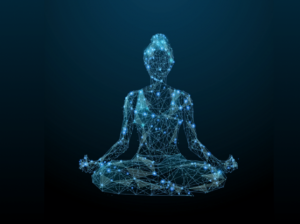
My introduction to the mindfulness practice of body scanning was amusing. I was taking a course at the University of Hong Kong with some 20 classmates from my Master in Buddhist Studies (MBS) cohort. We were exploring the intersection of psychotherapy and Jon Kabat Zinn’s Mindfulness-Based Stress Reduction (MBSR) program. It was a small class compared to most, and it was clear that we were excited to learn from the esteemed clinical psychologist Dr. Helen Ma.
This was our first formal meditation practice as a group and we were scattered across the room, some of us sitting in chairs, others lying on mats. Dr. Ma had instructed us to be comfortable; she was going to guide us through a 35-minute exercise that involved mentally scanning our bodies from the tips of our toes to the tops of our heads. We were full of anticipation as she began speaking in her soft, enunciated voice . . . and yet, within a few moments, the room full of serious Buddhist students was absolutely comatose. I personally lost track after reaching my knees, and some of us fell asleep even before that. I vaguely remember the sounds of heavy rhythmic breathing, rambunctious snoring, and the occasional flatulence. When we awoke, we were greeted with gentle humor by Dr. Ma.
“Nice try,” she told us, “but next time make sure you stay conscious—after all, the purpose of the practice is to be mindful.”
A few months later, I had the privilege of attending a Plum Village retreat led by Zen Master Thich Nhat Hanh who, together with Jon Kabat Zinn and other prominent figures such as Sharon Salzburg and Jack Kornfield, popularized mindfulness in Europe and the Americas. Each afternoon, a group gathered for a body-scanning practice conducted by the monastics. Their soothing presence matched the simple earth-colored robes they wore. It did not surprise me that, once again, many attendees fell into a deep slumber. Yes, we had lofty goals, but waking up at 4 a.m. each day to engage in a rigorous meditation routine made us relish any chance we had to relax and doze off.
As the days wore on and we practiced staying awake and alert for the entire exercise, patterns emerged. Some of us complained that we could not feel any bodily sensations, while others felt too much. Not to worry, the monastics reassured us, there is no right or wrong way to practice. We simply greet our bodies as they are right now and allow our sensations and our feelings to be what they are. Whether we feel numbness, a light tingling, or pronounced pain, we do not try to fix or change anything. The important thing is to observe what is without judging.

There is a common misconception that the purpose of mindfulness practices such as body scanning is to reach a state of calm and peace. As Dr. Ma and the Plum Village monastics highlighted, the practice is actually about being anchored in the present moment, through the body. The practice is rooted in the Early Buddhist Canon, when Shakyamuni Buddha instructs his followers on the value of being immersed in the body.* In his typical fashion, the Buddha lists noticing “unclean things” such as “body hairs,” “bone marrow,” “sweat” and “feces” (to name a few) as part of the process.
We are to bring focused awareness to all of our bits and pieces, whether pleasant, unpleasant, or neutral. This candid attitude makes me laugh, but it is also a skillful way of tapping into the heart of the matter. We are not seeking mental or bodily perfection: snoring, sweating, flatulence, aches, and pains, all of these are natural parts of being human. We may as well learn to ride the waves of sensations and feelings, rather than fight against them.
According to the Buddha, practicing this way can bring about “great fruit and great benefit.” Contemporary studies appear to support this claim: body scanning has been shown to have a positive impact on our overall health and well-being. Governmental institutions, such as hospitals and the Department of Veteran Affairs in the US, often recommended the practice in conjunction with traditional Western medicine. On an emotional level, it strengthens concentration and self-compassion, while reducing stress, anxiety, and depression, and has been reported to improve conditions such as asthma, chronic pain, and insomnia.

Perhaps more surprisingly, body scanning can significantly improve the way we behave and connect with others. When we befriend our bodies, and we greet them as objective observers, we gain a deeper awareness of the complexities that exist within us. This deep and embodied knowing can then be extended to others, creating new and exciting ways for us to show up in the world. Yes, there is suffering, perhaps in the form of tightening, nausea, itching, but there is also joy, softness, resilience, expansiveness.
The impermanent nature of all things is no longer something about which we merely reason intellectually; we sense it with our hairs, our skin, and our bones.
Nina Müller is a mindfulness practitioner who offers online mindfulness coaching sessions. If you would like to find out more, please visit The Mindful Practice to book a complimentary consultation.
* Kayagata-sati Sutta (Access to Insight)













